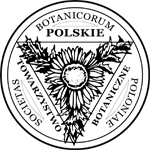Response of Fuchsia hybrida cuttings to flurprimidol and naphthaleneacetic acid application
Abstract
Keywords
Full Text:
PDFReferences
Abdelgadir H.A., Johnson S.D., Van Staden J. 2009. Promoting branching of a potential biofuel Jatropha curcas L. by foliar application of plant growth regulators. J. Plant Growth Regul. 58: 287–295. http://dx.doi.org/10.1007/s10725-009-9377-9
Abdi G., Ascari-Raburi N. 2009. Enhancement of IBA, urea-phosphate, paclobutrazol and their combinations on rooting of royal poinciana (Delonix regia) stem cuttings. Am-Eurasian J. Sustain Agric. 6 (2): 132–136.
Abdullah T., Malek A.A., Ahmad S.H. 1998. Chemical manipulation of growth and flowering in potted Melastoma decemfidum and Tibouchina semidecandra. Acta Hort. 454: 297–301.
Bunnell B.T., Cockreham S.D. 2005. New innovations with flurprimidol use on turfgrass, containerized ornamentals, and landscape ornamentals. Proc. 32th Ann. Meeting of Plant Growth Regulation Society of America: 101 (abstract).
Burkhart L.F., Meyer M.M. 1991. The gibberellin synthesis inhibitors, ancymidol and flurprimidol, promote in vitro rooting of white pine microshoots. Plant Cell Rep. 10: 475–476. http://dx.doi.org/10.1007/BF00233818
Darwati I., Rosita SMD, Hasanah M., Oniki M. 1993. The effect of plant growth regulator on the root growth of clove marcotting. J. Spice and Medicinal Crops, 11 (1): 31–35.
Davis T.D., Sankhla N. 1988. Effect of shoot growth retardants and inhibitors on adventitious rooting. In: Davies T.D., Haissig B.E., Sankhla N. (eds.) Adventitious Root Formation in Cuttings. Dioscorides Press, Portland, Oregon: 174–184.
Gent M.P.N. 2004. Efficacy and persistence of paclobutrazol applied to rooted cuttings of Rhododendron before transplant. HortSci. 39(1):105–109.
Grey T.L., Czarnota M., Potter T., Bunnel B.T. 2009. Timed release of flurprimidol from a granular formulation in mulches and sand. HortSci. 44 (2): 512–515.
Grossmann K. 1990. Plant growth retardants as tools in physiological research. Physiol. Plant 78: 640–648. http://dx.doi.org/10.1034/j.1399-3054.1990.780422.x
Hamid M.M., Williams R.R. 1997. Effect of different types and concentrations of plant growth retardants on Sturt’s desert pea (Swainsona formosa). Sci. Hortic. 71: 79–85. http://dx.doi.org/10.1016/S0304-4238(97)00107-6
Hartmann H.T., Kester D.E., Davies F.T., Geneve R.L. 2002. Principles of propagation by cuttings. In: Plant propagation, principles and practices. Prentice Hall, Upper Saddle River, New Jersey: 278–291.
Henrique A., Campinhos E.N., Ono E.O., Zambello de Pinho S. 2006. Effect of plant growth regulators in the rooting of Pinus cuttings. Braz. Archives Biol. Technol. 49(2): 189–196. http://dx.doi.org/10.1590/S1516-89132006000300002
Hwang S.J., Lee M.Y., Sivanesan I., Jeong B.R. 2008. Growth control of kalanchoe cultivars Rako and Gold Strike by application of paclobutrazol and uniconazole as soaking treatment of cuttings. Afr. J. Biotechnol 7 (22): 4212–4218.
Jankiewicz L.S. 1997. Retardanty i niektóre inne syntetyczne inhibitory wzrostu oraz wybrane substancje modyfikujące wzrost. [In:] L.S. Jankiewicz (ed.) Regulatory wzrostu i rozwoju roślin. Część 1. Właściwości i działanie. Wyd. Nauk. PWN, Warszawa: 108–123. (in Polish)
Kepenek K., Karoğlu Z. 2011. The effects of paclobutrazol and daminozide on in vitro micropropagation of some apple (Malus domestica) cultivars and M9-rootstock. Afr. J. Biotechnol. 10 (24): 4851–4859.
Kozak D., Grodek J. 2005. The consequent effect of growth retardants on the growth and development of Tibouchina urvilleana Cogn. shoots in vitro. Acta Sci. Pol. Hortorum Cultus, 4 (2): 123–128.
Kozak D. 2006. The effect of growth retardants applied in vitro on the acclimatization and growth of Tibouchina urvilleana cogn. in vivo. Acta Sci. Pol., Hortorum Cultus, 5(1): 65–70.
Million J.B., Barrett J.E., Nell T.A., Clark D.G. 2002. One time vs. continuous application of paclobutrazol in subirrigation for the production of bedding plants. HortSci. 37(2):345–347.
Nizam K., Te-chato S. 2009. Optimizing of root induction in oil palm plantlets for acclimatization by some potent plant growth regulators (PGRs). J. Agric. Technol. 5(2):371–383
Pan R., Gui H. 1997. Physiological basis of the synergistic effects of IBA and triadimefon on rooting of mung bean hypocotyls. Plant Growth Regul. 22: 7–11.
Pan R., Zhao Z. 1994. Synergistic effects of plant growth retardants and IBA on the formation of adventitious roots in hypocotyl cuttings of mung bean. Plant Growth Regul. 14: 15–19.
Premachandra G.S., Chaney W.R., Holt H.A. 1997. Gas exchange and water relations of Fraxinus americana affected by flurprimidol. Tree Physiol. 17: 97–103. http://dx.doi.org/10.1093/treephys/17.2.97
Rademacher W. 2000. Growth retardants: effects on gibberellin biosynthesis and other metabolic pathways. Annu. Rev. Plant Physiol. Plant Mol. Biol. 51: 501–31
Schuch U.K. 1994. Response of Chrysanthemum to uniconazole and daminozide applied as dip to cuttings or as foliar spary. J Plant Growth Regul. 13: 115–121. http://dx.doi.org/10.1007/BF00196374
Shanan N. T.A., Soliman A.Sh. 2011. Response of snapdragon plants to pinching and growth retardants treatments. Am.-Eurasian J. Sustain. Agric. (2): 150–157.
Shani E., Yanai O., Ori N. 2006. The role of hormones in shoot apical meristem function. Curr. Opin. Plant Biol. 9: 484–489. http://dx.doi.org/10.1016/j.pbi.2006.07.008
Syros T., Yupsanis T., Zafiriadis H., Economou A., 2004. Activity and isoforms of peroxidases, lignin and anatomy, during adventitious rooting in cuttings of Ebenus cretica L. J. Plant Physiol. 161: 69–77. http://dx.doi.org/10.1078/0176-1617-00938
Wiesman Z., Lavee S. 1994. Vegetative growth retardation, improved rooting and viability of olive cuttings in response to application of growth retardants. Plant Growth Regul. 14: 83–90. http://dx.doi.org/10.1007/BF00024145
Wiesman Z., Markus A., Wybraniec S., Schwartz L., Wolf D. 2002. Promotion of rooting and development of cuttings by plant growth factors formulated into a controlled-release system. Biol. Fertil Soils 36:330–334. http://dx.doi.org/10.1007/s00374-002-0553-6
Yadav R.K., Rai N., Yadav D.S., Asati B.S. 2005. Use of paclobutrazol in horticultural crops – a review. Agric. Rev. 26 (2): 124 – 132.
DOI: https://doi.org/10.5586/aa.2013.002
|
|
|






